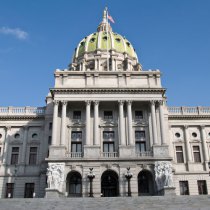Subscribe for Weekly Updates

State Budget Blues
By Peter Calcara, vice president – government relations
July marked my 31st anniversary working in and around Pennsylvania state government. It also marked my 30th state budget. Every year I marvel at how dysfunctional this process can be, but in the end it always seems to produce a viable plan for the operation of state government. It can be a remarkable process to watch unfold – the personalities, the issues, the politics. I’ve had a front-row seat to the madness. The past couple of budgets seasons, though – particularly the 2015-2016 process – set new lows for dysfunction in Pennsylvania.
 As I write this post, we are more than 80 days into the 2017-2018 fiscal year, and the state still does not have a complete budget. While operating without a budget in Washington has been business as usual for quite some time, it now seems that is becoming Harrisburg’s default method of operation.
As I write this post, we are more than 80 days into the 2017-2018 fiscal year, and the state still does not have a complete budget. While operating without a budget in Washington has been business as usual for quite some time, it now seems that is becoming Harrisburg’s default method of operation.
What is most surprising to me is how we got here. You may recall that in mid-June all the major stakeholders—Gov. Tom Wolf and the four legislative caucuses—had agreed to a budget framework. Just prior to the end of the fiscal year (June 30/July 1), Wolf and the leaders of the four legislative caucuses announced that they had reached an agreement on a nearly $32 billion spending plan for the 2017-2018 fiscal year. That plan is found in House Bill 218. The $32 billion budget was approved by wide margins in both the Senate and the House, 43-7 and 173-27 respectively. It went into effect on July 11.
Missing from the agreement is how to pay for the $32 billion in programs and services. There was no agreement on where revenues were going to come from. Try explaining this backward process to a bunch of CPAs! Not an easy task.
PICPA member: “So, the state decides first how much it’s going to spend, then comes back and agrees on how to raise the money to pay for the spend?”
Me: “Exactly.”
PICPA member: “That’s not how it’s supposed to work.”
Me: “Right.”
PICPA member: “What happens if they can’t reach an agreement on how to raise revenues?”
Me: “Not really sure.”
PICPA member shakes head or rolls eyes.
So, how long can this impasse last?
Both the House and Senate have approved revenue plans, but each has rejected the other body’s proposal. The fundamental disagreement for lawmakers is simply this: do we have a spending problem or a revenue problem? That’s the divide right now in the state Capitol. Many in the state House (and some in the Senate) feel that Pennsylvania spends too much, and should only spend what it brings in. Conversely, there is a group of state lawmakers that believe they can no longer ignore the trajectory of revenues. Operating state government’s programs and services simply costs more money year-over-year. The state cannot grow out of structural deficiencies, the thinking goes.
The Senate plan – found in House Bill 542 – raises more than $2 billion through a combination of recurring revenues, gaming expansion, and borrowing from the Master Tobacco Settlement Fund. HB 542 imposes a new severance tax on the Marcellus Shale industry, adds a new gross receipts tax on natural gas, and increases the gross receipts tax rate on telecommunications and electric companies.
The House closes the structural deficit without raising any new taxes. House Bill 453 would raise $2.4 billion through a combination of fund transfers, gaming expansion, and the monetization of a portion of the revenues from the Master Tobacco Settlement Fund. The revenues would fund the $1.5 billion deficit from 2016-2017 as well as the anticipated $600 million in revenue necessary for the current $32 billion state budget.
On Sept. 20, the Senate rejected the revenue plan outlined in House Bill 453 by a vote of 43-7. This will likely send the bill to a six-person conference committee where the leaders of the four caucuses will once again try to reach an agreement.
Bond rating agencies are not taking too kindly to this political stalemate. On Sept. 20, Standard & Poor’s downgraded Pennsylvania’s bond rating.
“The downgrade largely reflects the commonwealth’s chronic structural imbalance dating back nearly a decade, a history of late budget adoption, and our opinion that this pattern could continue,” S&P said in a statement.
What will a final revenue plan look like? Hard to say, but it likely will include a mix of recurring revenues, borrowing of funds from the tobacco settlement, and some form of gaming expansion.
Regardless, I am optimistic that a full and complete budget will be in place (including the revenue part) in the near future. Of course, don’t ask me to define “in the near future.”







Leave a commentOrder by
Newest on top Oldest on top